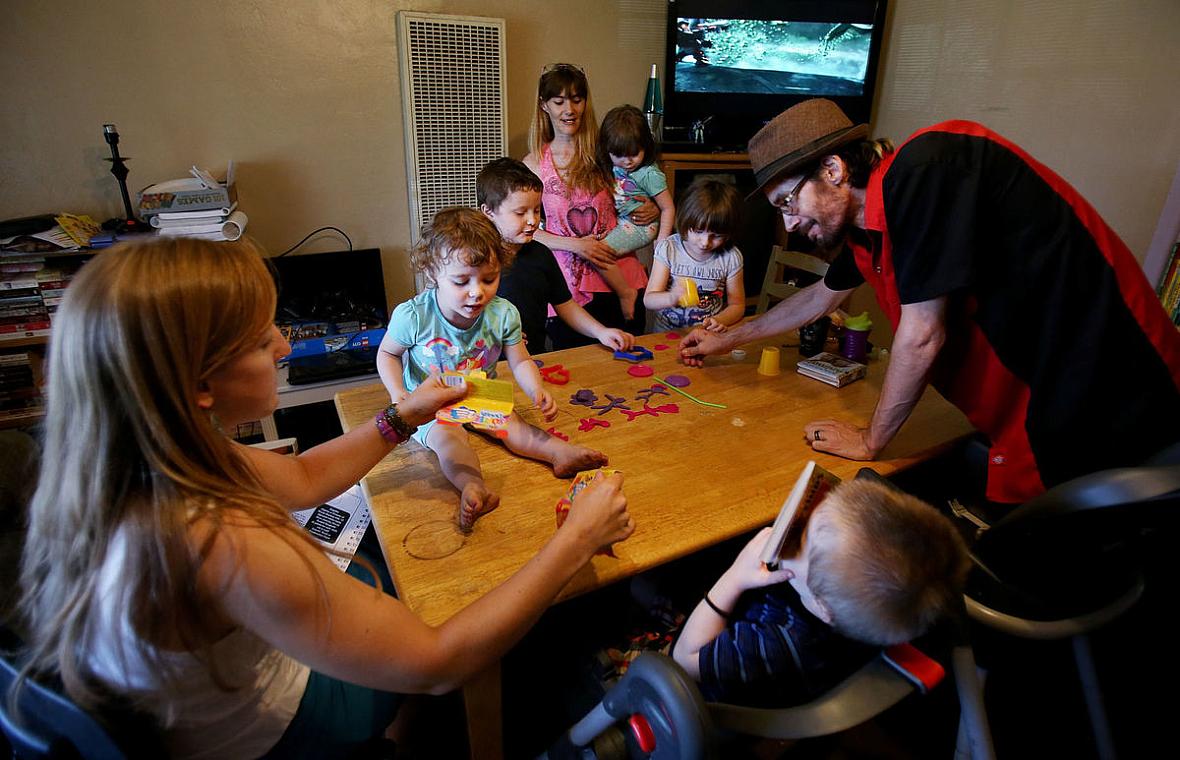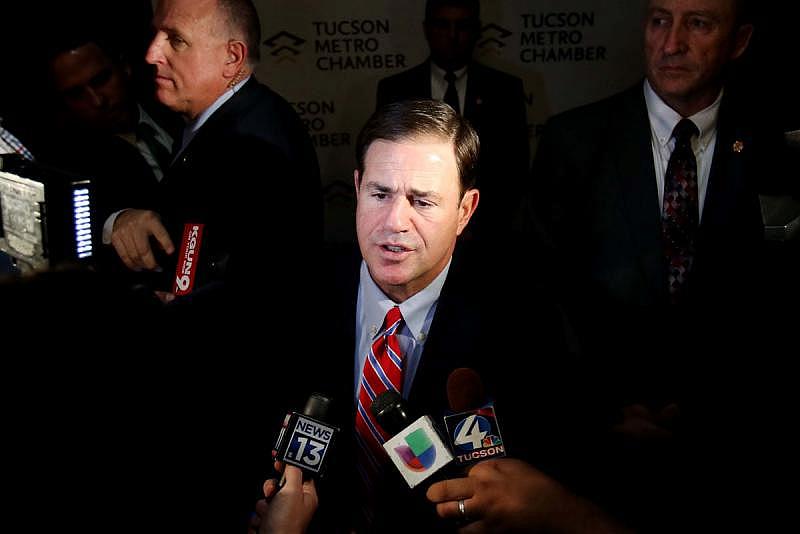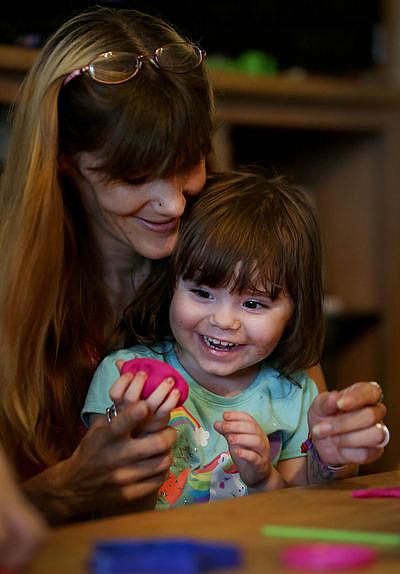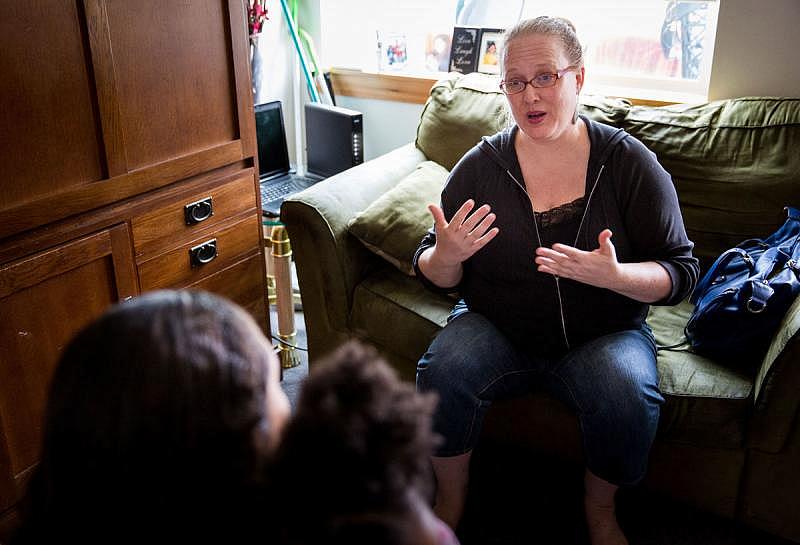Supporting families so kids aren't pulled from home
"Fixing our foster care crisis” was made possible through major funding from the Community Foundation for Southern Arizona and additional support from the University of Southern California Annenberg Center's Fund for Journalism on Child Well-being.

Angela Helseth, left, a family support specialist with Healthy Families, conducts an in-home visit with Nathan Wilson, right, Christine Haley, rear center, and their blended family of six children. Healthy Families has helped Wilson, a first-time dad, learn parenting skills. But because of state funding cuts, only 15 percent of eligible Pima County families can access the program.
Christine Haley was not yet 21 years old and about to have a child she wasn’t ready for.
Her own childhood, barely behind her, had been difficult. She’d been bullied, and she’d been in fights. But her worst memories are of being sexually assaulted.
As the years passed, she married and had more kids, but things didn’t get easier. Her life was chaotic, and she made decisions she regrets. For a time, her family was homeless as her marriage crumbled.
Through the benefit of therapy and supportive friends, she’s come to realize that her struggles were compounded by something that burdens many families involved with Arizona’s Department of Child Safety: constant, debilitating stress, now commonly referred to as complex trauma.
The trauma Haley carried into adulthood made raising children — difficult under the best of circumstances — extra challenging. Her family moved frequently. They were isolated and poor.
Haley, now 34, is trying to make better choices. And Arizona has choices to make about thousands of parents who are struggling, like she did.
Since the Great Recession started more than a decade ago, many Arizona families have languished as the state, facing budget shortfalls, cut services again and again. Lawmakers have slashed nearly $276 million since 2008 from programs and services that help families, data from the Children’s Action Alliance and the Joint Legislative Budget Committee show.
The cuts have made child care unattainable for thousands of families, and left the working poor with few supports. Foster care placements swelled and child neglect reports climbed from 9,850 in 2008 to nearly 19,300 by 2016.
The surge in child removals was intended to protect vulnerable children, but kids living in foster care are not necessarily safer and are more likely to face learning disabilities, developmental delays, depression, behavioral issues and obesity than kids who stay with their families — even troubled ones — recent studies show.
Thanks to changes in the Department of Child Safety, fewer than 15,000 Arizona kids now are in foster care. But to bring about lasting change, the state must help families long before a child safety caseworker knocks on the door, said Becky Ruffner, director of Prevent Child Abuse Arizona.
“Unless and until Arizona invests upstream in preventive services before they reach the crisis point, we’ll continue as we are,” Ruffner said.
Searching for solutions that could work in Arizona, the Arizona Daily Star talked with more than 100 experts in child-safety reform and traveled to six states to see what’s working there. Today, we share our findings about preventing family crises that can lead to child neglect and abuse; it’s the first of three installments of a special report we’ll publish on the first three Sundays in March.
Gov. Doug Ducey says Arizona has become a national leader in reducing foster care numbers, and indeed, there has been a significant drop, making caseloads in the Department of Child Safety more manageable. But to bring about lasting change, the state must help families long before a child safety caseworker knocks on the door, advocates say.
Kids in state care for too long
In his January speech to kick off the legislative session, Gov. Doug Ducey praised the Department of Child Safety, saying Arizona has become a national leader in reducing foster care numbers.
He’s right that there has been a significant drop, down from eight or nine of every 1,000 Arizona children to about five per 1,000. And with those declines come some other positives: DCS caseworkers now have far more reasonable workloads, down from an impossible 145 cases each to about 16.
In the last year, there’s also been a substantial dip in the number of foster kids living in emergency shelters or group homes, down from 2,360 in fiscal year 2016 to 1,880 in fiscal year 2017.
But kids in out-of-home care are still there too long. As of September, 24 percent of kids in state care had been there more than two years, and about 30 percent had been there for 13 months to two years. The state’s standard is to move children toward reunification with their family, adoption into another family or to a home with a permanent guardian within six months.
Advocates also agree that parents need more support while their children are in foster care so the same problems don’t continue. During fiscal year 2017, 20 percent of Arizona’s foster children who returned home were re-reported to the state for possible abuse or neglect within 12 months. Nearly 10 percent went back into foster care within six months.
The best way to turn that around is to address the most damaging effects of poverty — a lack of access to stable housing and affordable child care. Both can lead to neglect allegations that get children removed from their homes, said Richard Wexler, executive director of the National Coalition for Child Protection Reform. Child-care subsidies can keep parents from losing their children on “lack of supervision” charges; rent subsidies can keep them from being taken because parents can’t afford decent housing.
Beyond the societal value of helping families stay together, numbers show that the state’s attempt to keep kids safe by pulling them out of their homes simply hasn’t worked. Even with the surge in Arizona children put into foster care in recent years, the number dying of maltreatment jumped 16 percent between 2011 and 2015. That includes both kids under DCS watch and those the state didn’t know about until tragedy struck.
In Colorado, where several counties have made changes to keep more families intact, the number of children dying of maltreatment dropped 50 percent during that same period.
Untreated trauma
Addiction and mental health challenges, neglect and abuse tear families apart. But trauma and intergenerational poverty are often the underlying reasons.
Trauma, a word usually associated with car crashes and head injuries, is also what children endure from repeated exposure to excessively bad experiences.
Children are resilient and bad things don’t necessarily cause long-term problems. But when those bad things happen a lot, or in high doses, or when there’s two or three of them happening at once, the brain goes into high alert, all the time.
Abuse, neglect, a parent’s incarceration, hunger or seeing violence or addiction by adults in the household all change the way a child’s brain develops. Without help, that child will likely struggle with mental health issues, addiction and health problems.
Parents who endured trauma themselves can lack the ability to attach emotionally to their children or may not feel and express empathy toward their children.
Living in poverty makes it worse. Children from families earning less than $15,000 are 22 times more likely to be mistreated than those from families making more than $30,000, the National Incidence Study of Child Abuse and Neglect reports. That’s not because poor people are more inclined to abuse their children, but because poverty brings stress and dysfunction that can cycle from one generation to the next.
State and county data collected by the Arizona Daily Star shows that the Pima County ZIP codes with the highest needs for housing, utility and food assistance are also the areas that receive the most calls to DCS and had the most children removed from their homes. Those include 85705 on Tucson’s north side and 85706 on the south side.
Fallout from the failing family structure isn’t limited to an overburdened child safety system. The Tucson Fire Department has seen calls for help grow from just below 80,000 in fiscal year 2008 to 92,000 in fiscal 2017 — even as Tucson’s population dipped a bit.
The calls are often repeat requests for help with mental health challenges, addiction, a lack of utilities in the heat or cold and even loneliness, especially among the elderly.
The volume has strained the Fire Department’s system so much that in 2016 it launched the Tucson Collaborative Community Care (TC3) unit. The team includes a paramedic and a social worker who try to connect callers with the resources they need, freeing up emergency workers to handle medical issues and fires. On any given day, the TC3 unit has a waiting list of about 800.
The department has become, as Assistant Chief Sharon McDonough puts it, “this big safety net.”
Parenting classes
Christine Haley and daughter Lyns Wilson, 2, squish a ball of Play-Doh during a Healthy Families visit. Seventy-five percent of state funds for the program have been cut since 2009.
The first time DCS got involved in Christine Haley’s life was when hospital nurses overheard her husband say he would not change their newborn’s diaper.
Haley said the services brought in were helpful, but the marriage still ended. The second time DCS came to her door, she was a single mother. The concern was, again, neglect.
Haley, exhausted and raising her kids alone, had just finished a night shift driving a cab. A social worker from another agency, visiting to help one of Haley’s children, glanced in her window and saw her asleep on her couch with her children strapped into high chairs and toddler seats, watching television.
That visit launched services that have helped Haley with her children. What’s helped most, she said, is Healthy Families, one of Arizona’s best prevention programs. Haley and her fiance, Nathan Wilson, have learned about child development and school preparedness for their two youngest, twins, while also getting service referrals for her four other children.
“DCS recommended us to get parenting classes for Nathan, since he was a first-time dad, which led us to enroll with Healthy Families,” she said.
Healthy Families lasts for the first five years of a child’s life, with the aim of not only reducing the risk of child neglect or abuse, but also helping parents learn about brain development and the best ways to prepare children for school.
Families start out with home visits for one hour per week, then graduate to an hour every other week, and finally once a month.
Haley and Wilson are in their third year with the program, and both have found it extremely helpful.
Their first caseworker was “a sounding board to relieve stress,” said Wilson, who works in medical billing and coding. “They find out what each family needs, and they are nonjudgmental about what you are going through.”
Haley was briefly involved with Healthy Families once before, when a son from her first marriage was born. She participated about six months, she said, but was no longer eligible after he was found to be developmentally delayed and needing other services.
“They have listened and taken into consideration what our preference is in our home for parenting and social skills, combining it with their program teachings,” she said of Healthy Families. “It’s been a very supportive program for us.”
Their former caseworker, Angela Helseth, worked with them for a couple of years. “We help them in any areas where they are struggling.”
Healthy Families is “exactly what this family needs,” she said.
It’s also exactly what many other local families need — its success rate in Pima County is 96 percent, based on the number of participants that avoid foster care and stick with the program.
But only 15 percent of eligible families are able to participate, said Eric Schindler, president of Tucson’s Child & Family Resources, which administers the program here. About 75 percent of state funds for the program have been cut since 2009.
The only problem with Healthy Families, Schindler said, is there’s not more of it to go around.
Cindy Irwin is a therapist with Homebuilders, a Washington state program that focuses on helping families at high risk for having their children removed. It has been shown to save taxpayers $6.61 for every dollar spent.
Evidence-based programs
If helping families and children find better ways to live is not reason enough to invest in prevention, here’s another: It saves money.
That’s been a key factor in Washington state, where there’s been a sharp shift toward early intervention in recent years.
When Washington lawmakers want to measure a program’s success, they turn to the Institute for Public Policy in Olympia. Researchers there use what’s called meta-analysis to see how well programs work and what the state can expect to save over time.
One reason the institute is so successful is that it’s nonpartisan, said researcher Marna Miller, with as many Republicans as Democrats citing their findings during the state’s legislative sessions.
Programs are analyzed using a cost-benefit ratio. Successful programs show a cost-benefit ratio such as 1:4, which means it’s reasonable to expect that for every dollar put in, the return over time will be $4.
For example, an in-home prevention program called Homebuilders has been proven to save taxpayers $6.61 for every dollar spent. The program differs from Healthy Families in that it focuses on helping parents at high risk for having their children removed, while Healthy Families focuses on school preparedness and good parenting.
Programs that test well over time get an “evidence-based” stamp. As of a few years ago, the U.S. Department of Health and Human Services recognized 14 home-visiting programs as being evidence-based. Arizona uses a few of those, including Healthy Families, which is estimated to save about $14 for each dollar invested.
But these programs reach only a small fraction of the families that need them.
Arizona’s First Things First — a 2006 voter-approved initiative created to help children during their first five years — uses mostly evidence-based programming for its services. It relies on tobacco-tax funding and is not part of DCS, while playing a critical role in helping families with issues like poverty and as part of its focus on school readiness.
One of its best programs is Nurse-Family Partnership, which helps about 220 first-time mothers each year with support for a healthy pregnancy along with ensuring a newborn’s needs are met as they grow to age 2. The program was expanded here under the Maternal, Infant, and Early Childhood Home Visiting Program, reaching about 150 more mothers on Tucson’s south side through the Affordable Care Act.
Mothers are eligible if it’s their first pregnancy, if they are at less than 28 weeks gestation and if they are living under 200 percent of the federal poverty level. The evidence-based program has been around for about 40 years, said Joanne Karolzak, director of child and family services with Casa de los Niños. For every dollar invested, the program returns about $5.70, with a net savings of more than $34,000 per family served.
Another key program is Parents As Teachers, which — as the name suggests — focuses on helping parents be their child’s first teacher.
Joan Katz, coordinator of Parents as Teachers with Sunnyside Unified School District, had been working with preschool students who had language delays and noticed she was often helping two or three kids from the same family. So she started looking into ways to help the family as a whole.
Parents as Teachers fits perfectly, she said. Its four components include home visitation, group connections, parent-child time and referrals to other resources.
Here’s why these programs matter: The first five years of life are when the human brain is most open to absorbing new skills, including learning to communicate. It’s also a time when children, with the help of their parents and caregivers, learn self-regulation, which means learning about their emotions and how to calm down when they are upset.
Helping parents understand how a child’s brain develops — and how to have reasonable expectations about their young children — is critical to preventing abuse and neglect. This is especially true when parents and caregivers suffered abuse or neglect themselves, and are at risk of repeating the cycle with their own kids.
Worst fear not realized
The Department of Child Safety has been involved with Haley and her children several times over the years, but the agency has never done what she fears most: taken her children away.
Helping Haley at home averages about $4,600 for three months — a fraction of what it would cost to put her six children in foster care, which runs about $22 to $28 per day for each child, with the highest rate — for a medically fragile teen — at about $46 per day. Life in a group home averages about $3,500 per child per month.
DCS spending reflects how Arizona has prioritized foster care over prevention: In fiscal year 2017, $59 million of the agency’s budget went to licensed family foster care, which is just one type of out-of-home placement, while $28.9 million went toward in-home services.
Arizona prevention programs like Healthy Families and Building Resilient Families — which is not evidence-based, is not yet being used in Pima County and is being reviewed by Northern Arizona University researchers — cost the agency $15 million that same year.
Beyond the cost to Arizona, there’s also the lifetime breakdown of day-to-day expenses, which the Centers for Disease Control and Prevention outlines this way: If someone is dealing with the aftermath of significant trauma and has not received help, that person can incur $144,360 in lost productivity, $43,000 in childhood and adult health care, $14,000 in criminal justice and child safety costs, and $8,000 in special education costs.
Arizona scores high in this realm, the National Survey of Children’s Health finds, with about 31 percent of kids having experienced two or more adverse childhood experiences. The national average is 21.7 percent.
“When we look at the roots of social problems, we’re talking about origins in early life,” said Katie McLaughlin, director of the Stress and Development Lab at the University of Washington. “It’s not surprising that the cycles perpetuate.”
And when these children become adults who are “hard-wired for stress,” there should be little surprise when communities struggle with big issues.
The focus, therefore, needs to be on programs that help prevent or undo these cycles and help diminish poverty, decrease violence and address the “root causes” of trauma, McLaughlin said.
Everything else? She sums it up like this:
“Merely Band-Aids.”
**
[This story was originally published by Arizona Daily Star.]
[Photos by Mike Christy / Arizona Daily Star 2017.]
Other stories in Part 1 of this series include:
Upfront investments can ward off 'horrible outcomes'
Part 1: Arizona Daily Star special investigation: Fixing our foster care crisis
Scramble for social services draining for families already under stress
Negative cycles broken as families learn better ways to cope
Addiction underlies most abuse, neglect cases
Map: Search Pima County zip codes to see areas of high distress, DCS calls

